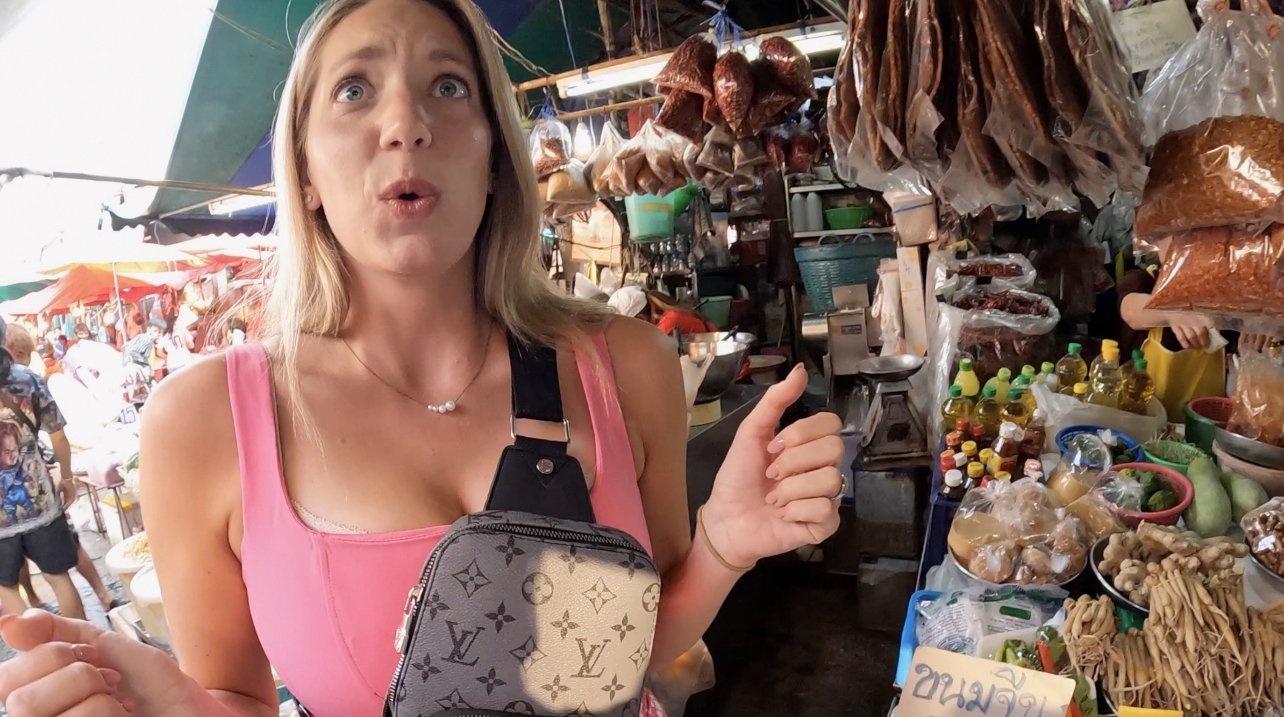Before I got to Thailand, I thought that Khlong Toei was a street food market.
I pictured little bamboo stalls with fresh pad thai, steamed buns, mango sticky rice, fresh basil, spicy eggplant curry- all of the romanticized imagery that I saw watching Anthony Bourdain when I was growing up.
But one morning during our trip, my boyfriend said he wanted to check out one of Bangkok’s most notorious slums with a well known wet market. We love getting off the beaten path, but when he mentioned the name of the slum, I realized it was the same “street food” market that topped my [very long] must eat in Bangkok list.
Wet market.
The first thing that comes to mind for most of us is COVID-19, and that’s because before the coronavirus pandemic, wet market wasn’t a household term in the United States. And because the Wuhan wet market is the most likely origination point of the pandemic (March 2023: COVID-19 origination with racoon dogs at Wuhan wet market, NY Times), wet markets don’t hold much appeal to most Western tourists visiting Asia.
So what was it like visiting the largest wet market in Bangkok, Thailand?
It was GRAPHIC. But here’s what I learned.
What is a wet market?
It was immediately obvious to me why it’s called a wet market. And trust me- if you decide to visit, do NOT wear sandals of any kind. You’ll want to burn your shoes.
A wet market is an outdoor complex of stalls selling live fish, meat, and wild animals. Live fish, stingrays, and sharks are splashing around in open tubs cascading water onto dirt walkways. The countertops of the stalls are wet (and red) with blood as fish, snakes, and mammals are gutted in front of you. Live turtles and crabs climb over each other in boxes, and melting ice adds to the gray water slush on the ground. Water, blood, fish scales, and pig guts spill out onto every walkway. Animals are skinned and butchered hanging from stall rafters in the sun- public executions- while files swarm and maggots abound.
Everything is wet.
Wet markets aren’t what you think they are. Can you eat at one?
Khlong Toei is a diverse labyrinth, and aside from the live butchering of meat and fish (including some unique things, like whole pig snouts and freshwater stingrays), there are also stalls with fruits, vegetables, and grains.
You should NOT eat anything at wet markets, even produce.
Aside from the risk of zoonotic disease, food poisoning, and any number of parasites from the temperature and sanitary conditions of the food, wet markets also:
-
Perpetuate the illegal wildlife trade
-
Encourage the unsustainable consumption of endangered animals
-
Circulate the dangerous and categorically false belief in “traditional” medicine
Also, rats. RATS. I’ll never be able to forget how many rats were scurrying under and around each dilapidated stall.
Pro tip: This sounds super appealing, right? If you’re coming from the US, Bangkok is a long (and usually expensive) flight. Use my step by step quick guide to learn how to use Google Flights to find the cheapest flights! And don’t forget to make sure you’re ready for a comfy flight with these long flight essentials.
Are wet markets safe? Or ethical? It’s complicated.
While I didn’t buy or consume anything at the wet market, I did leave with a lot of food for thought.
As a visitor welcomed into unique destinations, I firmly believe in putting aside the limits of my own perspective, keeping an open mind, and being sensitive to and respectful of local customs and rich cultural practices. I understand that what one person thinks is taboo, another sees as normal. We each have the beliefs and preferences that we do because we were born in a particular time and place.
So while I can appreciate the fact that wet markets are customary in this part of the world, objectively, this wet market was unsanitary and dangerous.
Conventionalism is the idea that right and wrong depend entirely on the cultures and traditions to which we belong. What one culture calls disgusting, another calls normal. Moral relativism comes into play here- the idea that there is no universal or absolute set of moral principles. But if we accept this, we also have to accept that endless atrocities and harmful practices — ritual sacrifice, female genital mutilation, child brides and labor — are objectively fine. Without a universal standard of morality, it’s difficult to declare that some behaviors are always wrong.
So where’s the line? What’s the answer when health and wellbeing intersects with cultural norms? I don’t think many governments or NGOs have the perfect answer to that yet.
Sounds gross. So why are wet markets still open in Asia?
The World Wildlife Fund said it best: “A complete ban is unlikely to be a sustainable solution to the health risks [of wet markets] – as earlier failed attempts at bans and shutdowns show. Instead, new policies and regulations need to incorporate scientific evidence together with consideration of different cultural perceptions and values towards wildlife, wildlife trade and consumption.”
Considering the consistently failed attempts of conservationists and governments to curb the illegal wildlife trade, poaching, the exotic pet trade, and other practices in this part of the world, I’m not optimistic. Who’s going to march into wet markets and stop locals from selling the fruits of their labor in these conditions? Is there going to be a “universal authority” of what’s too insanitary or unsafe to eat for particular groups of people? Who’s going to provide the resources for regulating and enforcing policies that are aimed at wet markets? And help locals that depend on earning money in this way redirect themselves to a different source or trade?
One thing’s for sure- I appreciated the experience for what it was, but I won’t be visiting another wet market any time soon. Would you?

LEAVE A COMMENT